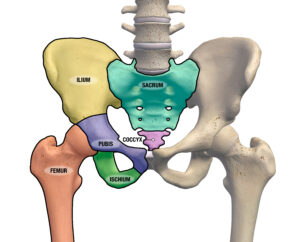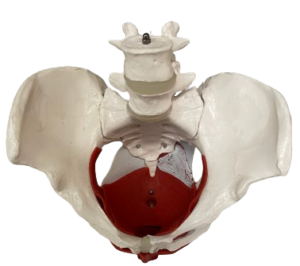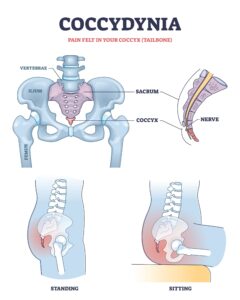Have you ever experienced a sharp pain at the base of your spine? Do you suffer from tailbone pain? Does it hurt when you sit? You may be experiencing something called coccydynia.
What is Coccydynia (and how do you pronounce it!?)
Coccydynia (kaak·suh·di·nee·uh) is simply a fancy medical term referring to tailbone pain, a common condition among adults. The tricky part about coccydynia is that it can have many different reasons for onset. Common causes of coccydynia include trauma (such as a fall onto the backside), pregnancy, vaginal birth, or prolonged sitting. This condition may even develop without any obvious mechanism of injury. Despite its small size, the coccyx serves an important function as an attachment site for many structures of the hips and pelvis.
Due to the complexity of this region, it can be difficult for people to identify or understand the exact cause of their pain. For some, the pain can progress to the point of interfering with everyday tasks such as being able to sit down at work or walk short distances. This can be an incredibly frustrating and difficult situation to deal with. Thankfully, there are people who can help. Pelvic floor physical therapists are providers who have special training in the structure and function of this area of your body and are therefore best equipped to treat this condition. Today we will be diving into some common causes of coccydynia and why you should seek out a pelvic floor physical therapist for help.
Quick Anatomy Overview

The coccyx (or tailbone) is a fusion of 4 small bones that connect to the end of your sacrum, marking the end of your spine. This structure serves as an attachment point for many muscles, tendons, and ligaments of the hips and pelvis. These attachments serve to support the pelvic floor and pelvic organs, distribute pressure across the pelvis while sitting, and help to provide stability in the area. Due to its central location and numerous attachment points, there are many structures that could contribute to the development of tailbone pain.
What is Causing My Pain?
As stated before, there can be many different causes for the development of this condition. Typically, a fall or other trauma to the tailbone can result in acute pain that may last for a few weeks and will generally resolve on its own. For some people, this pain does not subside and they can experience lingering symptoms that do not seem to improve over the course of weeks or months. In these more chronic cases, pain could be the result of muscle spasms, nerve injury, tendon or ligament strain, or poor movement patterns that lead to pulling around the tailbone. For example, many of the muscles of the pelvic floor (as pictured) attach to the tailbone and when they become tight, either on one or both sides, they can end up pulling significantly on the tailbone and the surrounding nerves.
tailbone can result in acute pain that may last for a few weeks and will generally resolve on its own. For some people, this pain does not subside and they can experience lingering symptoms that do not seem to improve over the course of weeks or months. In these more chronic cases, pain could be the result of muscle spasms, nerve injury, tendon or ligament strain, or poor movement patterns that lead to pulling around the tailbone. For example, many of the muscles of the pelvic floor (as pictured) attach to the tailbone and when they become tight, either on one or both sides, they can end up pulling significantly on the tailbone and the surrounding nerves.
This is just one example of how symptoms of coccydynia can develop. In the next section, we will dive a little deeper into why a pelvic health physical therapist is the right provider to evaluate and treat this condition.
How Pelvic PT Can Help
As mentioned previously, pelvic PTs are physical therapists who have received further specialized education after PT school in order to better understand and treat the pelvic floor and surrounding areas. Coccydynia happens to be one of the conditions we specialize in. Your experience with a pelvic PT will start with an in-depth physical examination of your movement, palpation of external structures, and questions regarding your symptoms. Depending on your reported symptoms, your physical therapist may suggest an internal pelvic floor examination. Your provider would discuss that examination process in detail and would only perform with your comfortable consent. There is never any pressure to complete the pelvic examination and it may not be deemed necessary based on your symptoms. It could, however, provide information that fits the missing piece of the puzzle, especially if you have been treated for this condition before by a traditional orthopedic physical therapist without relief.
Following the evaluation, your PT will discuss the cause of your symptoms and establish a treatment plan to help get you back to pain-free activity. A treatment plan may include therapeutic massage to release tight structures, education on movement and posture, exercises to help improve muscle activation and pelvic mobility, and more. As with any condition we treat, our plan of care will be tailored to you as an individual in order to meet your goals and help you regain your quality of life. Coccydynia is a very treatable condition and one you do not have to keep suffering through!
If you have any questions regarding this information, or if you have been suffering from similar symptoms and would like to get help, give us a call or send us a message today!






